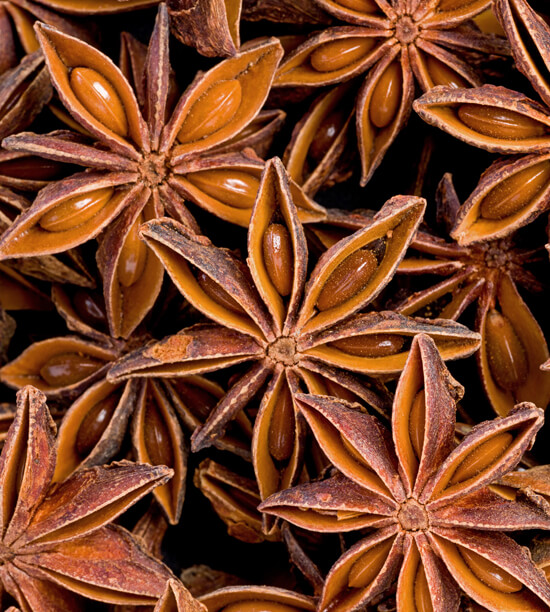The escalating demand for anti-aging and skin-whitening products is driven by widespread concerns over skin aging, often exacerbated by overexposure to oxidants and UV radiation. These environmental stressors trigger enzymatic reactions, notably increasing tyrosinase activity, which is a key enzyme in melanin biosynthesis. Excessive melanin production in the epidermis leads to hyperpigmentation, a characteristic sign of photoaging. Consequently, the discovery of effective tyrosinase inhibitors is crucial for developing novel skin-whitening agents.
Star anise (Illicium verum Hook.f.), a spice traditionally used in herbal medicine for various biological activities including antibacterial, antioxidant, and anti-inflammatory properties, presents a promising natural solution. Historically, I. verum has been incorporated into traditional body treatments, such as “mandi rempah” in Indonesia, where it was known to support new skin cell growth, accelerate wound healing, moisturize the skin, eliminate body odor, and provide anti-aging benefits. Despite this empirical knowledge and its rich phytochemical profile, there has been a notable lack of scientific evidence specifically demonstrating I. verum‘s ability to alleviate skin hyperpigmentation. This gap highlights the urgency for scientific investigation into its anti-tyrosinase potential, which this study aimed to address.
Methods
The study comprehensively assessed Illicium verum‘s potential through both in vitro and in silico approaches. Its essential oil and extract underwent phytochemical profiling using Gas Chromatography-Mass Spectrometry (GC-MS) and Liquid Chromatography-Mass Spectrometry/Mass Spectrometry (LC-MS/MS), respectively. The tyrosinase inhibitory activity was evaluated via in vitro enzymatic assays for both samples, utilizing kojic acid as a positive control. Furthermore, in silico molecular docking studies were conducted to predict the anti-tyrosinase activity of individual phytochemicals by targeting the tyrosinase (5M8P) protein, alongside an assessment of their physicochemical and ADME (Absorption, Distribution, Metabolism, Excretion) properties.
Key Findings
• Phytochemical Composition: GC-MS analysis identified twenty secondary metabolites in I. verum oil, with trans-anethole (32.36%) being the major compound. LC-MS/MS detected ten compounds in I. verum extract, including notable phenolic and flavonoid compounds like rutin, ferulic acid, gingerol, and quercetin-3-O-β-xylopyranoside.
• Tyrosinase Inhibition (In Vitro): The essential oil demonstrated significantly stronger tyrosinase inhibitory activity (IC50 = 216.27 ± 2.18 µg/mL) compared to the extract (IC50 = 12484 ± 147.80 µg/mL). Both were less potent than the positive control, kojic acid (IC50 = 46.43 ± 1.74 µg/mL).
• Molecular Docking (Oil): Cis-caryophyllene emerged as the strongest binder among the oil constituents, exhibiting the best docking score (∆G = -7.72 ± 0.01 kcal/mol) to the tyrosinase (5M8P) protein. This binding affinity was superior to both the native ligand (TYR, ∆G = -5.86 kcal/mol) and kojic acid (∆G = -4.56 kcal/mol). Cis-caryophyllene primarily interacted with histidine residues (His381, His192, His215, His377).
• Molecular Docking (Extract): For the extract, gingerol displayed the highest docking score (∆G = -5.88 ± 0.16 kcal/mol), slightly surpassing the native ligand and significantly outperforming kojic acid. Gingerol formed both hydrophobic interactions and hydrogen bonds within the binding pocket.
• ADMET Properties: Most identified compounds generally exhibited favorable physicochemical properties for drug candidates, adhering to Lipinski’s rule of five. High human intestinal absorption (>90%) was predicted for most compounds, with rutin being an exception (23.446%).
• Skin Permeability: From a topical perspective, most oil compounds showed low skin permeability (Log Kp values generally greater than -2.5 cm/h), indicating good retention on the skin surface. However, gingerol (-2.817 cm/h) and ferulic acid (-2.72 cm/h) from the extract showed good skin permeability, making them promising for transdermal delivery in topical formulations.
• Toxicity Predictions: Trans-anethole and gingerol were classified as Class III (toxic if swallowed, LC50 150-250 mg/kg), while cis-caryophyllene and most other compounds were Class V (harmful if swallowed, 2000 < LD50 ≤ 5000). Cis-caryophyllene and gingerol were also predicted to be active in immunotoxicity. It’s important to note that oral toxicity predictions do not directly correlate with topical application safety.
From a topical application perspective, these findings hold significant implications for future cosmetic formulations. The predicted favorable skin permeability of gingerol and ferulic acid from the extract suggests their potential for effective delivery in skin-whitening products. While some compounds showed predicted oral toxicity, this is less relevant for topical use, making I. verum constituents promising for cosmetic development.
Future research should prioritize bioassay-guided fractionation to isolate cis-caryophyllene and gingerol for individual testing, which would provide more precise insights into their specific mechanisms of tyrosinase inhibition through enzyme kinetics. Further validation using melanocyte cell line cultures is crucial to assess their actual impact on melanin content and to perform cytotoxicity assays. Ultimately, studies incorporating I. verum oil into cosmetic formulations, followed by evaluations using human skin models, are necessary to confirm efficacy, safety, and stability for real-world anti-aging and anti-hyperpigmentation applications.
Link to the study: https://tinyurl.com/bd6pt5um

